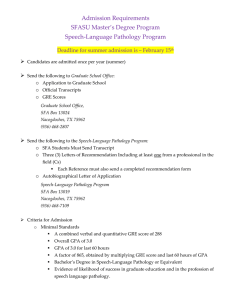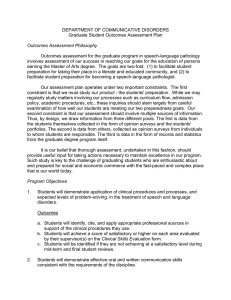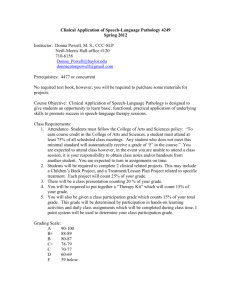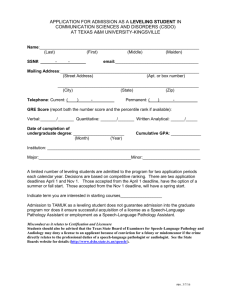Commission on Teacher Credentialing Biennial Report California State University, Fresno
advertisement
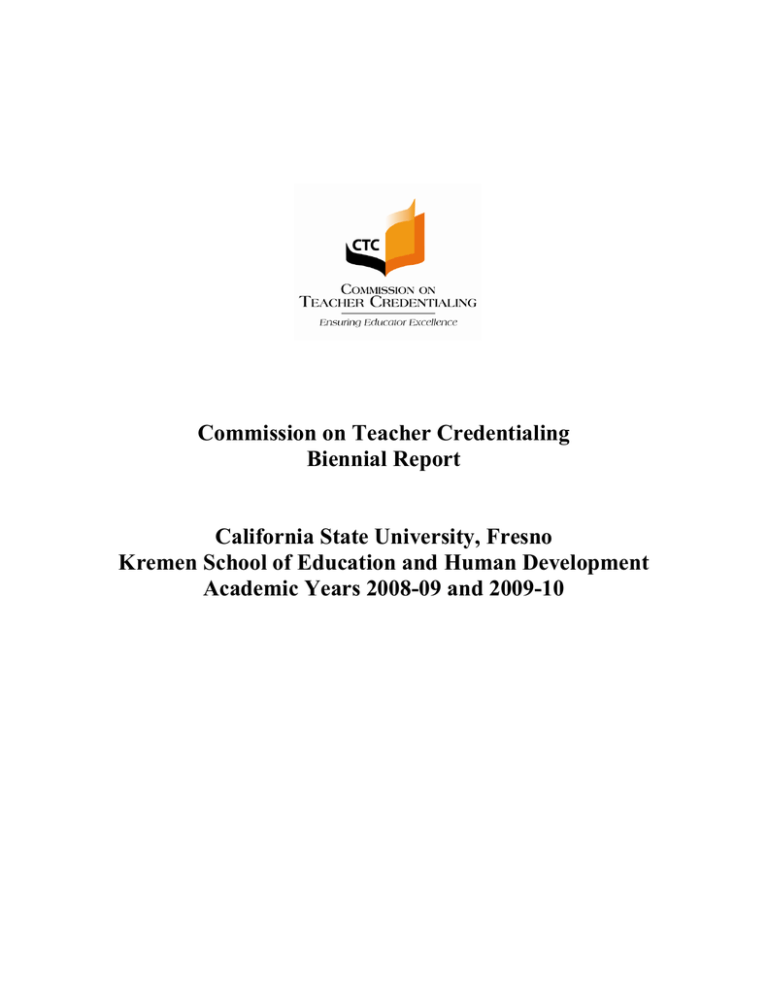
Commission on Teacher Credentialing Biennial Report California State University, Fresno Kremen School of Education and Human Development Academic Years 2008-09 and 2009-10 Commission on Teacher Credentialing Biennial Report Academic Years 2008-09 and 2009-10 Institution California State University, Fresno Date report is submitted October 15, 2010 Program documented in this report Speech-Language Pathology Services Name of Program Speech Pathology Credential awarded Speech-Language Pathology Services Is this program offered at more than one site? If yes, list all sites at which No the program is offered Program Contact Sharon Inouye Phone # 559.278.2443 E-Mail sinouye@csufresno.edu If the preparer of this report is different than the Program Contact, please note contact information for that person below: Name: Phone # E-mail California State University, Fresno: 2009-2010 Section A-1 Contextual Information Speech Pathology Department of Communicative Disorders and Deaf Studies The faculty in the Department of Communicative Disorders and Deaf Studies have developed three goals which serve as practical guidelines for our speech pathology program. First, we want to be recognized as a premier, interactive department where students are trained to become effective speech-language pathologists. Second, we want to have a curriculum that provides a deep understanding of communicative disorders and prepares students for professional careers in a variety of work settings and with populations demonstrating linguistic and cultural diversity. Third, we strive to maintain our student-training partnerships with private and public agencies, so as to provide varied and realistic clinical experiences for our students. These three goals provide direction for the following curricular objectives: • To prepare students for passing the PRAXIS exam, acquiring national certification, school credentialing, and state licensing. • To prepare students for pursuit of doctoral degrees. • To prepare students to complete a minimum of 36 hours of graduate coursework, including a course in research methods and application. • To prepare students for completion of an acceptable master's thesis, graduate project, or written comprehensive examination. • To enable speech-language pathology students to complete 400 clinical clock hours of practicum preparing them for clinical positions in private practice, rehabilitative centers, skilled nursing facilities, public schools, and other professional settings. All graduating MA-level speech pathology students complete the academic and clinical requirements for the clear Speech-Language Pathology Services Credential as a normal part of our program. In the 2008-09 academic year, we admitted 37 students into the speech pathology graduate program. In the 2009-2010 academic year, we admitted 26 students. Twenty-six students graduated from the program during the 2008-2009 academic year, and 32 students graduated from the program during the 2009-2010 academic year. Changes Since Commission Approval of Current Program Document Date Ongoing • Addition of off-campus practicum sites Spring 2010 • Survey of clients’ progress in treatment Spring 2010 • Analysis of Knowledge and Skills Acquisition Forms (KASA). California State University, Fresno: 2009-2010 Section A-2 Contextual Information Speech Pathology Department of Communicative Disorders and Deaf Studies A. Candidate Assessments the program uses to and through recommending credential. List 4-6 Key Assessments (not admissions data) 1. Praxis II Speech-Language Pathology Test scores 2. Speech pathology graduate students exit interviews 3. SLPS Candidate Dispositions Evaluation (Table 1) 4. SLPS Evaluation of Candidate Performance in Educational Field Placement 5. Knowledge and Skills Acquisition (KASA) forms Summary of Data Praxis II Speech-Language Pathology Test scores The Praxis II Speech-Language Pathology Test evaluates the beginning clinician's knowledge of fundamental speech-language pathology concepts, as well as current practices in the field. Passing this test is necessary to obtain the ASHA Certificate of Clinical Competence and state licensure. In addition, California Assembly Bill 2837 requires candidates for the California clear Speech-Language Pathology Services Credential to pass this test. Nearly all speech pathology graduate students in our program take this test near the end of their graduate studies. Here are the passing rates for our students since 2002: 2010 (to date) – 89% 2009 - 100% 2008 - 100% 2007 - 100% 2006 - 94% 2005 - 89% 2004 - 100% 2003 - 100% 2002 - 85% Speech pathology graduate student exit interviews - During the final week prior to graduation, all graduate students are asked to participate in exit interviews. These sessions are held in small groups of 1-4 students and conducted every year. The results of these interviews are shared with faculty during faculty meetings. Potential changes to the program are discussed based on the data. 2008-2009 - A total of 4 students participated in the exit interview process. All 4 of them were SLP students. No Deaf Education students attended the exit interviews. Possible strategies for increasing student participation were discussed as a faculty but no conclusion was reached. Students identified their perceived strengths and weaknesses of the speech pathology program. Their input is discussed with the faculty and areas of potential weakness are discussed and modifications to course assignments are modified to best meet the students’ needs. 2009-2010 - A total of 6 students participated in the exit interview process. Three of them were SLP students, and three of them were Deaf Education students. Possible strategies for increasing student participation were discussed as a faculty but no conclusion was reached. Students identified their perceived strengths and weaknesses of the speech pathology program. Their input is discussed with the faculty and areas of potential weakness are discussed and modifications to course assignments are modified to best meet the students’ needs SLPS Candidate Dispositions – An existing clinical practicum evaluation tool is utilized to evaluate each candidate’s acquisition of professional dispositions. This data was collected during the Fall 2008-Spring 2010 semesters for candidates enrolled in their SLPS educational field placement. Candidate demonstration of each disposition was rated by the field instructor on a scale of 1-5, with “1” representing inadequate and “5” representing excellent. A rating of “4” represents good and is considered to be the benchmark for meeting program requirements. The data for fall 2008 through spring 2010 are depicted in Table 1. Table 1: 2008-2010 Evaluation of Candidate Dispositions at Program Completion Rating Scale: N/A= Not Applicable/Not addressed yet 1= Needs 100% Assistance/Feedback: Inadequate (Inability to make changes). 2= Needs 75% Assistance/Feedback: Nominal (regularly needs specific direction/demonstration). 3= Needs 50% Assistance/Feedback: Adequate (often needs some general direction/demonstration). 4= Needs 25% Assistance/Feedback: Good (needs occasional direction/demonstration). 5= Independent with Minimal Assistance/Feedback: Excellent (takes initiative and performs effectively) Candidate Disposition Values Diversity Communicates Effectively Collaborative Ethical Confidential TOTAL Mean (15) Fall 2008 4.95 Mean (1-5) Spring 2009 4.6 Mean (15) Fall 2009 4.6 Mean (1-5) Spring 2010 % Meeting Benchmark 4.8 94% 4.95 4.8 4.6 5.0 96% 4.95 4.9 5.0 4.95 4.9 4.8 4.6 4.7 4.7 4.95 4.7 4.7 4.9 4.9 4.9 4.9 96% 98% 96% 96% Each semester the data is analyzed and student performance is reviewed by the Clinic Director. Faculty is consulted throughout the school year to address any specific areas of student weakness. B. Additional information collected on completer performance and program effectiveness. Exit interviews are completed each academic year. All other Outcome Assessment Measures are collected and analyzed based on a 5 year cycle/schedule that has been created. These measures are described below. Those that were administered or acted upon during the period of this report are presented/discussed in the Table below (Section A-4). 1. Evaluation of Candidate in SLPS Educational Field Placement at Program Completion . Each semester, supervisors and master teachers complete an evaluation of the students under their supervision. Those items reflecting the students’ performance is averaged (per item) and tracked across semesters. 2. Employer Survey. With the approval of each alumnus, a survey is sent to his or her employer. The results for each item on the numeric scale are averaged. 3. Alumni Survey. Each alumnus is sent a survey. The results for each item on the numeric scale are averaged. 4. Minutes of Advisory Committee. Professionals from Fresno County are members of the Deaf Education and Speech Pathology Advisory Committee. This committee meets to provide feedback regarding program development in the Department. The minutes of these committees’ meetings are analyzed and areas of strength or needed change will be noted and summarized. Final recommendations are presented to the faculty for consideration. 5. Graduate Writing Requirement Results. The percent of students passing the graduate level writing requirement is calculated each year. Major reasons for fails are noted for program review. This information is presented to the faculty. 6. Comprehensive Examination Results. This data includes the number of (a) students passing, (b) passing in oral examinations, and (c) failing the comprehensive examination per academic year. 7. Knowledge and Skill Acquisition Forms (KASA). This data includes: (a) # of students enrolled in class, (b) # of students that successfully completed classroom presentation and research paper on the first try, (c) # of students that needed remediation, and (d) the # of students who ultimately passed by the end of the semester. California State University, Fresno (09-10) Section A-3 Use of Assessment Results to Improve Candidate and Program Performance Speech-Language Pathology Services The assessment data presented in the prior sections of this report indicate that the program is successfully preparing students for employment as speech pathologists in the public schools. They are passing the national examination for speech pathologists at a very high rate, and they also are successfully completing the SLPS Educational Field Placement assessment at nearly 100% for all items. The following list shows our analysis of the data: Program Strengths: • • • • Students continue to pass the PRAXIS examination with a high success rate. Based on supervisor evaluations and other assessments, a significant number of students demonstrate strong academic and clinical skills in diagnostics, treatment, writing, and ethics during their educational field placements. All graduating students met the program’s indicators for demonstration of professional dispositions. The program has added a required graduate course on autism, based on student and community feedback regarding our curriculum. This was an “area of improvement” in our last report. Areas for Improvement: • • • Expand the number and variety of practicum placements, which should enhance student exposure to a range of disorders. Writing Measureable Goals and Objectives (see Action discussion/table in Section A-4) Graduate level writing requirements (see Action discussion/table in Section A-4) California State University, Fresno (09-10) Section A-4 Use of Assessment Results to Improve Candidate and Program Performance Speech-Language Pathology Services Data Source Student Outcomes Assessment Plan (SOAP) Data Action(s) Focus Proficiency • Exit Interview. Graduate with students will be knowledge individually interviewed of by members of the academic, Department’s Outcomes clinical, Assessment Committee. and Contact Person Fran Pomaville Timeli ne June 2009 Results Completed (June 2009 & 2010) results were summarized earlier in this report. research learning theory and practices. • PRAXIS Results - The number of graduate students passing or not passing the PRAXIS Examination in Speech Pathology and Audiology (PRAXIS) will be summed for the academic year. Fran Pomaville • Graduate Writing Requirement Results. The percent of students passing the graduate level writing requirement each year. Major reasons for fails will be noted for program review. • New Actions: 1) A grad assistant will be hired by dept. to assist grad students with the mechanics of writing. 2) Use of new APA 6th edition manual in all grad classes. 3) Deaf Ed will increase instruction on using APA in CDDS 114. Fran Pomaville June 2009 Met - results were summarized earlier in this report. June 2009 June 2010 June 2010 June 2010 • Comprehensive Exam Results. The number of students who pass comprehensive exams will be tallied. Results will be shared and discussed with faculty with subsequent actions taken, as needed. June 2010 • New Actions: 1) Dr. Skelton offered a new Comps Social that focused on the process and requirements for the exam. 2) Writing Measureable Objectives was identified as an area of weakness, so June 2011 June 2011 Met – Data collected revealed that passing rate (68%) was below the benchmark (80%). As a result, three new steps were taken (see “new actions” listed to the left). All three steps were implemented by the target date of June, 2010. Completed. Results revealed that the passing rate (75%) did not meet the benchmark (80%). As a result, 4 new actions were taken (see “new actions” listed to the the faculty identified “key components” to be emphasized in the following classes: 220, 116, 213, 215. In addition, a simple guide /book was reviewed and will be adopted for use in 209. 3) The criteria for grading comps was discussed and clarified among the faculty. Student Proficiency • Incorporate discussion of Practicum with current professional issues Evaluation professiona in CDDS 209 seminar. (CDDS 257 l and – ethical Educationa aspects of l the Fieldwork) educational setting related to speech pathology. Consult with educational fieldwork supervisors to obtain specific information regarding SLPS candidates strengths/weaknesses. left). June 2010 Met Sharon Inouye June 2009 Completed (June 2009) Invited SLPs working in varied community (medical and educational) settings to discuss current issues they were facing each day in the workforce to CDDS 209 class. Sharon Inouye June 2009 Completed June 2009 Specific candidate strengths and weaknesses were identified on the student practicum evaluation while students were enrolled in CDDS 257. Students’ New: Survey of Clients’ Progress in Treatment Clinician’s • Maintain data to reflect Treatment the total number of Effectivene treatment objectives that ss were: (a) targeted for each client (b) met (c) not met but significant progress was made towards meeting the objective. (d) not met. Sharon Inouye June 2010 areas of strength and weakness were discussed and strategies to increase specific skill areas was provided to the student and guided under the direction of the master teacher. Goal met 66 clients 26 clinicians Total # of objectives addressed ranged from 2-10 135/262 goals were met = 51.5% 65/262 goals were not met but significant progress was made = 29% 51/262 goals were not met = 19.5% The clinicians’ treatment efficacy was addressed throughout the semester by the clinic supervisor and treatment revisions were implemented as needed. June 2011 In progress CALIFORNIA STATE UNIVERSITY, FRESNO BIENNIAL REPORT – SECTION B I have reviewed and am submitting the attached biennial reports for California State University, Fresno and the institutional plan that includes trends observed, areas of strengths, areas for improvement, and next steps for our institution. _______________________________________ Dean Paul Beare, Director of Teacher Education ___10/10/10________________ Date Institutional Summary and Plan of Action Since the last biennial report in December 2008, the professional preparation programs at Fresno State have continued to offer quality programs, use assessment data to determine needs, and recruit and grow in identified areas of need. Individual programs meet as a program faculty. Larger programs such as the Multiple and Single Subject have identified review committees that meet often to make needed changes and recommendations to the Dean. The program coordinators from across the university are convened by the Associate Dean of the Kremen School of Education and Human Development (KSOEHD) at least three times a year. The KSOEHD Dean (Director of Teacher Education) meets with all program coordinators at least once a year to review the institution’s goals, needs, and direction. SUMMARY The programs’ biennial reports utilized a wide variety of assessments to inform their practice. Each program focuses on their candidates’ knowledge, skills, dispositions, and ability to apply theory to practice in their fieldwork/clinical settings. Assessments are used to inform the candidate, to determine their fitness to be recommended for a credential, and to inform and improve the program. After review of these reports and the information provided from the Chancellor’s Evaluation, the following trends, areas of strength and improvement, and next steps were developed to represent issues that crossed the institution or involved multiple programs. TRENDS • • • • Decreased enrollment in Multiple Subject program. Increased enrollment in Advanced Credential programs – particularly cohorts for the Educational Administration credential. Increased use of assessments to inform practice. Increased use of assessment data to conduct research on variables affecting credential candidates quality. AREAS OF STRENGTH • • • • Program completions – Programs across the university report completion rates at greater than 90%. Employer opinion/rankings and hiring of our candidates – Employer surveys are used by many of the programs with strong and positive scores reported by an average of 80% on the Chancellor’s (basic teaching credentials) survey and of 90% from local program surveys. Partnerships/Cohorts in districts – Fresno State has placed cohorts of students in partnership schools for both basic credential and advanced credential programs. Currently, there are 12 partnerships districts. Recruitment - Fresno State has more than doubled the number of mathematics and science teaching credentials recommended in the past 4 years as a result of the highly successful MSTI (Math, Science Teaching Initiative) program. AREAS FOR IMPROVEMENT • • • Preparation of teachers and other education professionals in issues related to English Learners. Preparation of teachers to teach students with special needs in inclusive settings. Continued recruitment of candidates in high-need areas; special education, single subject – math and science – and recruitment of male candidates, in general, and more specifically males of color. NEXT STEPS • • • • Targeted professional development in EL across the accreditation unit. In the basic teacher credential programs, targeted professional development in issues related to special needs students in general education classrooms. Support recruitment in identified high-need programs and with targeted candidates. Use of CTQ and FAST data to research the impact our graduates are having on the students they teach, particularly on their student achievement as measured by state accountability systems. ACTION PLAN Data Source Data Focus Action(s) FAST, CTQ, Program Exit Surveys and assessments English Learners FAST, CTQ, Exit Surveys SPED in inclusive classrooms Application and enrollment data Application and enrollment data Math & Science recruitment and retention Recruitment of males in basic credential programs Impact research • Share data with program committees • Course-alike meetings • Syllabi/Assignment/Module additions • Faculty development • Share data with MS/SS/ES committees • Course-alike meetings • Syllabi/Assignment/Module additions • Faculty development • Marketing/recruitment plans • CSET Test Prep coursework • Set enrollment targets • Track data on enrollment • Marketing/recruitment plans • Set enrollment targets • Track data on enrollment FAST, CTQ • Review annual assessment data • Identify potential variables • Research correlations among candidate data and achievement data of their students Contact Person All NCATE Program Coordinators Timeline Basic Credential Coordinators 2010-12 MSTI Coordinator 2010-12 Basic Credential Coordinators 2010-12 Dean and Assoc Dean 2010-12 2010-12
